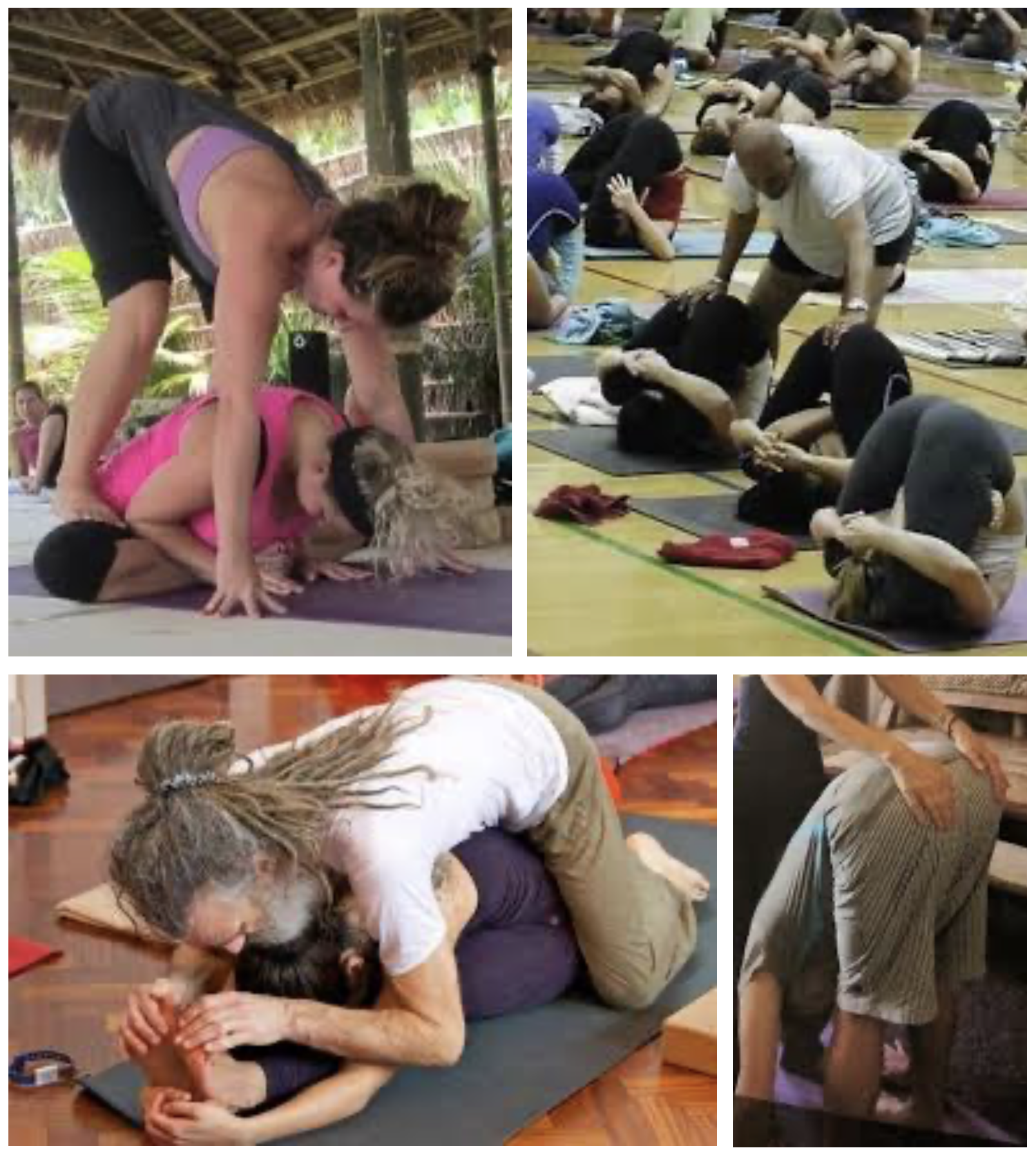Give Your Yoga Students Real Choices In Their Practice
The conversations around a yoga teacher’s scope of practice are rapidly changing. Consent is a big one. Consent encompasses how we teach our classes and especially how we offer adjustments. In some cases, where a student with disability needs to be physically manipulated in order to get any movement to the body, touch is essential. As a yoga teacher, do we have the right to walk up to student and start adjusting them? What if they don’t want to be touched? Do we blindly assume that all adjustments are better for the student? On whose terms?
Most yoga teachers don’t think about the repercussions of their adjustments and presume that there is no foul in doing so. I disagree.
Google search results: “inappropriate yoga adjustments”
My first negative experience of a hands on adjustment was back in 2002 in California. I attended a fun and rigorous yoga class taught by an extremely handsome yoga instructor (who was also J Lo’s yoga instructor). He taught only wearing loose cotton pants. Bare chested, he would affectionately walk around the class to provide very intimate adjustments to students. The class was full of women who loved it. They would moan in orgasmic pleasure as he would adjust them and I froze. As he made his way around the room, I was increasingly nervous for him to reach me. But I carried on.
Just as I was at my most vulnerable positions, Ardha Chandrasana (and balancing for the first time without toppling over), he came up from behind me, placed one hand on my inner thigh to pull me more open. I was mortified! I “fell” out of the pose purposefully and gave him a non-verbal cue that touching wasn’t appropriate for me. Lucky he got the point and avoided giving me any hands on adjustments. I wasn’t injured but uncomfortable and had to go elsewhere to practice my yoga from then on.
Touch is very personal. The energy and tone of a person’s touch can be healing or down right offensive. But shouldn’t students be given the choice of whether they want an adjustment or not? What if they are fine in the beginning but change their minds halfway through a class?
I would like to share a very safe approach to consent in yoga and offer some solutions for you to evolve your teaching practice:
The Four Tenets of Consent
In order for consent to be true and for our students to make empowered choices in the way they practice, consent needs to be: clear, coherent, willing and ongoing.
Clear: Yoga teachers and students need a shared language (verbal or non-verbal) to communicate ‘yes’ and ‘no.’ Secondly, if a student is unsure, it’s important for them to be able to freely express this as well. “I don’t know…” usually is a request for more information. As yoga teachers, we are teaching students to become the masters of their bodies and minds, so our job is to empower them to say what they mean, and mean what they say.
Coherent: A student must be coherent to give true consent. A student should not be under the influence of any substances that may impair judgement. This means that they must be awake and not asleep, unconscious or frozen in a state of trauma. How many teachers come up to students (with the best of intentions) to give a touch or adjustment when students are in their most vulnerable state of Savasana or Yoga Nidra (deep relaxation). If a student is not coherent, yoga teachers can undeniably interpret that as ‘no.’
Willing: Students must be enthusiastically willing for consent to be true. Again, if a student expressing uncertainty, it’s up to the teacher to offer true choices, instead of coercion or manipulation. Most yoga teachers will read this and think that they don’t teach like this. I implore you to think again. If you teach yoga with a hierarchy of variations “This is the full expression of the pose…,” or “If you cannot do this pose, just rest in child’s pose…,” this is a breeding ground for manipulation via peer pressure. It implies that a student is less than the others if they cannot strive toward unrealistic expectations on their bodies. A teacher often comes into a class with a power over the students. For students to be willing to participate, it’s up to the teacher to give students true choices of practising in tangible options that accommodates everyone and promotes equality and equity. It requires extra effort on the part of the teacher.
Ongoing: Consent needs to be ongoing. Students need to be able to change their minds in both directions and as often as they like. They may willingly accept an adjustment at the beginning of class and then decide that they no longer want to be manipulated somewhere in the middle. This is perfectly okay. Develop your teaching style to accommodate this. Never assume.
Four Ideas to Adjust Your Teaching Style
Free and happy to have choices!
Set ground rules in class: As you introduce your class, you can give guidelines to students to help manage their expectations. There are many ways different teachers approach this. Some examples:
“It’s important to follow your own body first before blindly listening to my instructions”
“This class is not about me telling you what to do. It’s about you finding your own way to feel strong and supple”
“There is no one way to practice yoga. Whether you are flexible or not, everyone will receive the benefits of yoga”
“If a posture looks too difficult to attempt, I will offer options for you to try and see what works in your own body.”
Breaking poses down into options (not levels): If you are teaching an advanced pose, take time to break the pose down into fundamental steps. What is the first step a complete beginner in your class can do to receive an experience? What’s the next step. Encourage students to stay in each step and explore it. Call each step an “option.” Try giving three options for practice and then let the choice be the students. (Making sure you don’t place a hierarchy on the options).
Demonstrate adaptive variations: Yes, as a teacher demonstrating advanced poses can be very inspiring to some, however remember that the class is not a performance. It’s a how to guide for moving the body. This means that if you show your students that your own choices are respectful to yourself, you are leading by example. If you demonstrate a more adaptive variation, many students can understand the point of their practice better.
Consent badges: Offer your students consent badges at the beginning of every class and let them know that they can switch it up every time. Have small double-sided print out that says: “Yes! I’m okay with hands-on adjustments,” on one side, and “No. Please do not touch me,” on the other.
Learn adjustment etiquette: I can write a whole blog post about this one, but I’ll save that for another time. In short, it follows this: never single a person out. Instead take all steps necessary for students to be able to self-adjust. If that does not work and you have to make a hands-on adjustment (provided you have the permission to), follow the four tenets of consent above.
Yoga has a really bad name these days. There is so much abuse of power from a teacher to a student. A yoga teacher does not need to tell students what to do. To me, the true role of a yoga teacher is to guide students towards an inner exploration of their true self.
A master rule of thumb is to return to the first of the Yamas: Ahimsa — do no harm to yourself and others. The ethical treatment of all living things includes the students in your class.
How do you give choices to your students in class?


